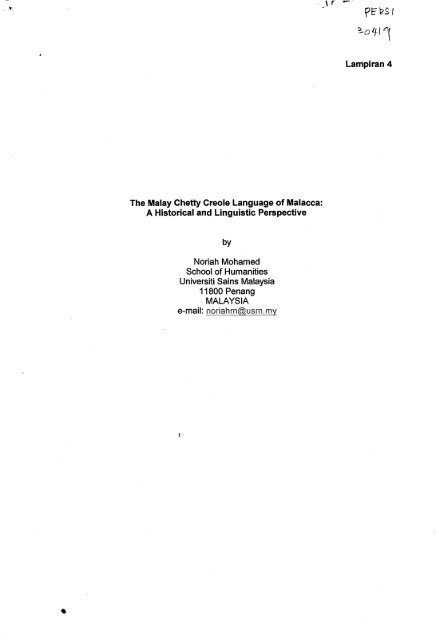The Malay Chetty Creole Language of Malacca: A ... - ePrints@USM
The Malay Chetty Creole Language of Malacca: A ... - ePrints@USM
The Malay Chetty Creole Language of Malacca: A ... - ePrints@USM
Create successful ePaper yourself
Turn your PDF publications into a flip-book with our unique Google optimized e-Paper software.
THE MALAY CHETTY CREOLE LANGUAGE OF MALACCA:<br />
A HISTORICAL AND LINGUISTIC PERSPECTIVE 1<br />
Abstract<br />
This article is an attempt to describe the <strong>Malacca</strong> Chetties' historical and linguistic<br />
background. It begins with a discussion <strong>of</strong> the emergence <strong>of</strong> the Chetties who are<br />
descendents <strong>of</strong> two ethnically and culturally different groups, Indian men from South<br />
India and local women <strong>of</strong> <strong>Malacca</strong>. <strong>The</strong> intermarriage between the two groups, which<br />
was common especially before the arrival <strong>of</strong> Islam and throughout the Hindu-Islam<br />
transition period in <strong>Malacca</strong>, gave birth to this unique community. In terms <strong>of</strong> physical<br />
appearance, the Chetties' look more <strong>Malay</strong> than Indian, yet they maintained their<br />
Indian ancestors' Hindu beliefs. <strong>The</strong> Chetties' draw and adapt from other local cultures,<br />
in particular the Saba Nyonya and <strong>Malay</strong> cultures, in their every day life. <strong>The</strong> mother<br />
tongue <strong>of</strong> the Chetties for instance is a variety <strong>of</strong> <strong>Malay</strong>. As with the community itself,<br />
the <strong>Malay</strong> language used by the Chetties is an amalgamation <strong>of</strong> various cultures.<br />
Grimes (1996) labels the language spoken by the Chetties as a form <strong>of</strong> creole and<br />
names it Chetties <strong>Creole</strong> <strong>Malay</strong> or <strong>Malacca</strong> <strong>Malay</strong> <strong>Creole</strong>. <strong>The</strong> uniqueness <strong>of</strong> the<br />
language is explicated further in the second part <strong>of</strong> this article which discusses the<br />
linguistic similarities and distinctions between the Chetties <strong>Creole</strong> <strong>Malay</strong> and other<br />
<strong>Malay</strong> dialects in <strong>Malay</strong>sia.<br />
1 This article is a part <strong>of</strong> a research report funded by the Universiti Sains <strong>Malay</strong>sia Short Term IRPA Grant<br />
entitled "Deskripsi Leksiko-Fonologi Bahasa Kreol Melayu Chitty Melaka" from April 2004 - May 2006.<br />
2<br />
"
Introduction<br />
<strong>The</strong> term <strong>Chetty</strong> originates from the word chetti in <strong>Malay</strong>alam, shetti in Tamil and setti<br />
in Telegu, all <strong>of</strong> which refer to people from South India from the Chettiar caste. A<br />
review <strong>of</strong> the literature suggests that there are variations to the word including Chetin,<br />
Chati, Chatin, Chettijn, Sitty and so on (Moorthy, 1997: 40t In the context <strong>of</strong><br />
<strong>Malay</strong>sia, the term <strong>Chetty</strong> generally refers to the Chettiars whose roots could be traced<br />
back to Kampung Keling in <strong>Malacca</strong>. <strong>The</strong> community is known for its socio-economic<br />
position as money-lenders, and because <strong>of</strong> the strong affiliation with this group, the<br />
word <strong>Chetty</strong>, in the local context generally connotes 'money-lenders'.<br />
Whilst it is true that <strong>Chetty</strong> means money lenders known as nagarathar nattukkottai<br />
chettiars (Rabeendran, 1976: 6), what is not generally known is that the term also<br />
refers to another community, the <strong>Malacca</strong> Hindu Babas. Also known as the Hindu or<br />
Indian Babas, the main settlement <strong>of</strong> this group in <strong>Malay</strong>sia now is in Kampung 7 in<br />
Gajah Berang, also an area in <strong>Malacca</strong>. <strong>The</strong> <strong>Chetty</strong> families have been living in the<br />
area for six generations (Narayanasamy, 1976: 21). Although this is the case, the<br />
number <strong>of</strong> people in the community has overtime decreased and to date there are<br />
approximately 200 members <strong>of</strong> about 30 families still living there.<br />
\'<br />
This community is known as· the Babas as it resulted from intermarriages between<br />
merchants from South India and local women in <strong>Malacca</strong> during the 1600s. <strong>The</strong><br />
merchants who were mostly Tamil Hindus married and settled with local women <strong>of</strong><br />
various ethnic backgrounds including <strong>Malay</strong>s, Javanese, Bataks and Chinese. <strong>The</strong><br />
2 In this article, the generally accepted terms <strong>Chetty</strong> and Chetties (plural form) are used.<br />
3








![[Consumer Behaviour] - ePrints@USM](https://img.yumpu.com/21924816/1/184x260/consumer-behaviour-eprintsusm.jpg?quality=85)








